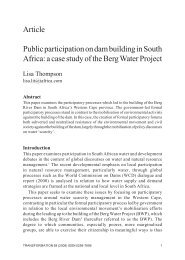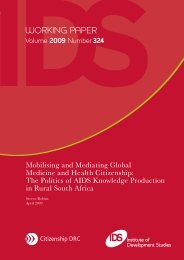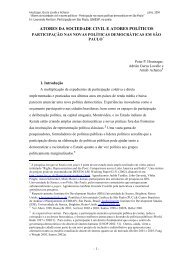Associations and the Exercise of Democratic ... - Citizenship DRC
Associations and the Exercise of Democratic ... - Citizenship DRC
Associations and the Exercise of Democratic ... - Citizenship DRC
Create successful ePaper yourself
Turn your PDF publications into a flip-book with our unique Google optimized e-Paper software.
IDS WORKING PAPER 285status. 36 The models we find for active citizenship, mobilising government (anycombination <strong>of</strong> direct, contentious, or brokered relations), <strong>and</strong> <strong>the</strong> direct relationsare parsimonious <strong>and</strong> yet are <strong>the</strong> ones with highest explanatory power (AppendixB, tables B.1 <strong>and</strong> B.2). The models for São Paulo are generally stronger than <strong>the</strong>ones for Mexico City <strong>and</strong> allow us to make stronger claims for <strong>the</strong> former cityregarding <strong>the</strong> factors that affect <strong>the</strong> three dependent variables. Although asubstantial number <strong>of</strong> citizens in São Paulo have direct relations with <strong>the</strong>government, we can only define a weak model to explain this relation. In MexicoCity <strong>the</strong> number <strong>of</strong> citizens with direct relations is small <strong>and</strong> no model could bedefined. There is <strong>the</strong>refore an asymmetry in <strong>the</strong> presentation <strong>of</strong> <strong>the</strong> models. Fordifferent reasons in each city, discussed below, it was also not possible to definemodels for detached relations.It is difficult to interpret <strong>the</strong> coefficients <strong>of</strong> models corrected for endogeneity <strong>and</strong>selection biases. Fur<strong>the</strong>rmore, we can rule out <strong>the</strong>se problems in our specifications.We <strong>the</strong>refore interpret only <strong>the</strong> probit models. The models <strong>the</strong>mselves, <strong>the</strong>irspecifications, <strong>and</strong> how we address possible problems <strong>of</strong> endogeneity <strong>and</strong> selectionbiases are discussed in Annex B. 375.1 Explaining active citizenship <strong>and</strong> civil relations: basic modelsThe probit models reveal that three explanatory factors are consistently highlysignificant for active citizenship, mobilising government, <strong>and</strong> in São Paulo direct civilrelations (Appendix B, Tables B.1 <strong>and</strong> B.2). These factors are associationalparticipation, education, <strong>and</strong> some aspects <strong>of</strong> labour market status. A few o<strong>the</strong>rvariables, which do not add much explanatory power are included in <strong>the</strong> modelsbecause <strong>the</strong>y are widely believed to influence citizenship activity <strong>and</strong> provide <strong>the</strong>bases for clear hypo<strong>the</strong>ses. The religion variables, for example, are only weaklysignificant for active citizenship in São Paulo, yet <strong>the</strong>y test <strong>the</strong> hypo<strong>the</strong>sis thatparticular religious groups contribute to making <strong>the</strong>ir participants active citizens. Inthis case we find that religious participation is not an important determinant <strong>of</strong>active citizenship or <strong>of</strong> any o<strong>the</strong>r dependent variables.In Mexico City detached civil relations are numerous but we do not find a meaningfulmultivariate model to explain <strong>the</strong> prevalence <strong>of</strong> <strong>the</strong>se relations. Our inability tospecify a model for detached in Mexico City suggests that such relations arer<strong>and</strong>omly distributed across <strong>the</strong> population for <strong>the</strong> variables we consider. Detached36 A probit model is used ra<strong>the</strong>r than a logit model because <strong>the</strong> residual <strong>of</strong> estimates reportedbelow were roughly normal.37 The problem <strong>of</strong> endogeneity arises in our model due to <strong>the</strong> possibility that individuals whoparticipate in associations do so in order to exercise some aspect <strong>of</strong> <strong>the</strong>ir citizenship. Thus<strong>the</strong>re can be dual causality, as one <strong>of</strong> <strong>the</strong> explanatory variables is not determined exogenous<strong>of</strong> <strong>the</strong> dependent variable.Selection bias may occur because <strong>the</strong>re may be some unobservable factors among individualsthat are highly correlated with participation in association <strong>and</strong> seeking out active citizenship.Individuals who decide to be active <strong>and</strong> to participate in associations <strong>the</strong>refore stem from<strong>the</strong> presence <strong>of</strong> <strong>the</strong> same factor, <strong>and</strong> which we have not taken account, possibly becausewe could not observe this factor.32





